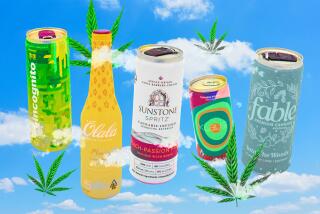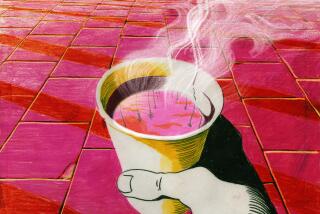Flavor stays in, buzz stays out
- Share via
I sometimes drink decaf -- even before it gets dark out -- and I used to be ashamed of saying so. “What’s the point?” said regular coffee drinkers. This was the stuff that garnered sneers and jeers, or at least raised brows, from aficionados gathered around the cupping table.
But decaf coffee drinkers now can feel vindicated, because a deep, rich, flavorful -- even exciting -- cup of decaf is realizable.
“People are regularly astounded,” says Peter Giuliano, director of coffee for Durham, N.C.-based Counter Culture Coffee and board member of the Specialty Coffee Assn. of America, who conducts weekly consumer tastings and often includes decaf. “They always say, ‘I can’t believe that it’s decaf.’ The message I always try to send to other coffee people in the industry is you’ve got to respect the decaf drinker more. And to decaf coffee drinkers, I say don’t allow yourself to be treated like the ugly stepchild.”
It seems some have already gotten that message. The variety and quality of decaffeinated coffee have grown, roasters are paying more and more attention to their decaf offerings, and consumers are drinking more of it. Decaf represented 18% of U.S. coffee consumption in 2005, up from 12% in 2000, according to the National Coffee Assn.
To remove all that caffeine -- 97% of it must be extracted to meet the international standard -- the beans have to go through some distress; they’re heated or steamed or soaked or exposed to chemicals. The consequence is that flavor is altered, but decaffeinators constantly are tweaking their methods to better preserve flavor. “Individual plants have perfected their technique, and they’re really good at it,” Giuliano says. And much of the onus of making a great decaf lies with the roaster.
Decaffeination occurs after fruit picking and drying but before roasting. A handful of decaffeinators operate facilities in North America and Europe. Roasters either ship their own beans to these decaffeinating plants, known as tolling, or buy beans from the plants “off the rack.” (Large companies such as Kraft Foods Inc. have their own facilities.)
The three main processes for decaffeination use carbon dioxide, water or chemical solvents such as ethyl acetate, which is found naturally in fruit so it’s often referred to as a “natural process,” and methylene chloride -- a solvent that also has industrial uses such as removing paint, but experts say that because it evaporates quickly, coffee drinkers aren’t exposed to any residue. Coffee companies often won’t indicate decaffeination methods on their packaging unless it’s water-processed, as it’s the most marketable.
Nobody seems to agree on which method best maintains the inherent flavor characteristics of the coffee beans, and different processes can have varying effects on different beans. “I blind cup decaf coffees of all methods,” says Chuck Jones, owner of Jones Coffee Roasters in Pasadena. “I prefer whatever process tastes the best.”
The majority of coffee still is decaffeinated with methylene chloride, but among specialty roasters, a shift away from chemicals continues, especially as demand for organic coffee increases. Coffee labeled organic can’t be decaffeinated with chemicals, of course. Specialty roasters such as Groundwork Coffee Co. in Los Angeles and Intelligentsia Coffee in Chicago are transitioning to all water-processed decaf. The big name in water processing is Swiss Water Decaffeinated Coffee Co., which runs a plant in a suburb of Vancouver, Canada. Another company, Descaffeinadores Mexicanos, uses a rival water process called Mountain Water (and also offers methylene chloride decaffeination) at a plant in the state of Veracruz.
“We’re growing at 12% to 15% annually [in volume],” says Swiss Water President Frank Dennis, “but our organic is growing at about 20% to 25%.”
Starting out with high-quality beans is tantamount to the success of a decaf coffee. Once decaffeinated, the beans are more volatile and benefit from extra care by roasters.
How you brew decaf has an effect on flavor too. Decaf should be prepared a little differently than regular coffee. Most experts agree that regular coffee is best brewed at 190 to 200 degrees. Decaf, on the other hand, should be brewed with water that is a little hotter, between 202 and 210 degrees. And the ratio of ground coffee to water should be higher. Two tablespoons of ground regular coffee is enough for 8 ounces of hot water, but for decaf, two tablespoons is enough for about 6 ounces of hot water.
Happily, these days, there’s a lot of decaf to choose from, not just that single house-blend stuff that was meted to decaf drinkers only as an afterthought.
“The decaf market is getting better and better, and you can find wonderful decaf now,” says Joan Nielsen, co-author of “The Great Coffee Book” and a decaf drinker herself. “More roasters are conscious and conscientious of their decaf programs.”
But there’s still room for improvement and a wider variety of decaf offerings. “I’d give my right arm for a decaf Yergacheffe,” Nielsen says.
*
*
(BEGIN TEXT OF INFOBOX)
But is there a difference in taste?
THE Times Tasting Panel convened one recent late afternoon -- a good time for decaf -- to compare a few decaffeinated coffees with their full-throttle counterparts. Joining me on the panel were staff writer Corie Brown, deputy food editor Susan LaTempa, staff writer Charles Perry and restaurant critic S. Irene Virbila. We tasted three pairs of coffees roasted by Supreme Bean of North Hollywood, regular and decaf in each case. The question: Could we tell the difference between decaffeinated or not in each pair?
* Coffee: Decaf Sumatra (its nondecaf counterpart: Sumatra Karo Highlands)
Decaffeinating method: Ethyl acetate
This was the favorite; only one panelist identified it as decaf. A lush cup that we preferred to the regular Sumatran, with some rich chocolate and sweet tobacco flavors and a long finish. Sumatrans are known for making good decaf, and this one did not disappoint. It tasted even better than the nondecaf, with some of the bean’s mustiness smoothed out.
* Coffee: Decaf Organic Rainforest Blend (its nondecaf counterpart: Organic Rainforest Blend)
Decaffeinating method: Swiss Water
Panelists were split on pinpointing this one as decaf, though it was not nearly as rich as the Sumatran. It showed a bit of cinnamon aroma, but otherwise it did not have much complexity or dimension. The nondecaf counterpart had better flavor and much more body.
* Coffee: Decaf Brasil (its nondecaf counterpart: Brazil Santos Prima Qualita)
Decaffeinating method: Methylene chloride
This cup closely matched its caffeine-full counterpart in flavor and body. It had a delicate aroma, was light-bodied, a little sweet but also simple, with good acidity (though some claim that methylene chloride creates false acidity). Not much on the finish.
-- Betty Hallock
More to Read
Eat your way across L.A.
Get our weekly Tasting Notes newsletter for reviews, news and more.
You may occasionally receive promotional content from the Los Angeles Times.











